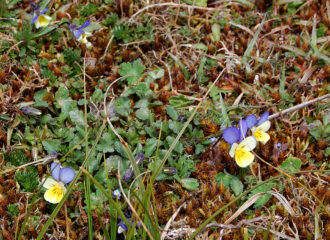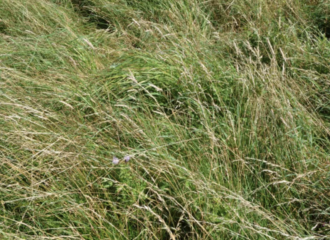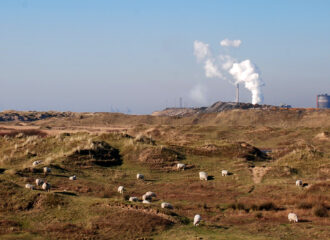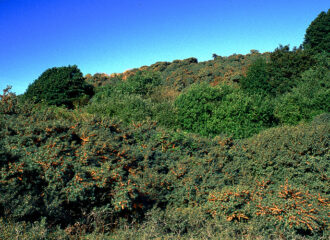Dune grassland forms on the slopes and ridges of the hind-dunes. The grassland can vary greatly in form, ranging from open, sandy pioneer vegetation to closed and tall vegetation dominated by rank grasses and scrub. The key reference states are described in the sections below.
Dune grassland

Reference state 1 -Successionally-young dune grassland
Successionally-young dune grassland is found on the dry slopes of the hind-dunes – sometimes near the tops of the dune ridges on older and more stable systems. These young grassland habitats typically have a visible presence of bare sand and some cover of Cladonia lichens, notably C. foliacea, and mosses, particularly the sand-hill screw-moss (Syntrichia…
Read more Reference state 1 -Successionally-young dune grassland

Reference state 2 – Fixed dune grassland
Fixed dune grassland forms on the sloping dunes to the landward side of the foredunes. This closed grassland can be both colourful and species-rich and hosts a number of rare and declining species. Two core species of the habitat are red fescue (Festuca rubra) and lady’s bedstraw (Galium verum), with pyramidal orchid (Anacamptis pyramidalis) a…

Reference state 3 – Rank dune grassland
Species-poor rank dune grassland dominated by false oat grass (Arrhenatherum elatius) and cock’s-foot (Dactylis glomerata) is becoming increasingly common as dune systems in Wales stabilise. The lack of sand accretion and diminishing area of pioneer habitats is resulting in succession to more mature habitats.

Modified state 1 – Non-native conifer plantations
Large areas of dune grassland in Wales have been planted with non-native conifer plantations, including on several Natura 2000 sites. At these sites, the consequences are not only associated with the loss of dune grassland habitats, the take-up of water for transpiration by these plantations can also have a lowering impact on the water table,…

Modified state 2 – Overgrazed grassland and slack habitats
Overgrazing has two significant impacts on dune grassland habitats. Firstly, on systems already in the process of succession to mature species-poor habitats, the nutrient input from large numbers of grazing animals will exacerbate the situation. Secondly, large numbers of grazing animals, and particularly sheep, will cause a significant reduction in the number of plants setting…
Read more Modified state 2 – Overgrazed grassland and slack habitats

Modified state 3 – Non-natural dune stabilisation
The most obvious dune scrub species in Wales is sea buckthorn (Hippophae rhamnoides), which is widely believed to be a non-native species on west coast UK dune systems. Sea buckthorn was deliberately introduced to Welsh dune systems to help stabilise the mobile dunes. Now, after a 100 year period of dune stabilisation, sea buckthorn can…

